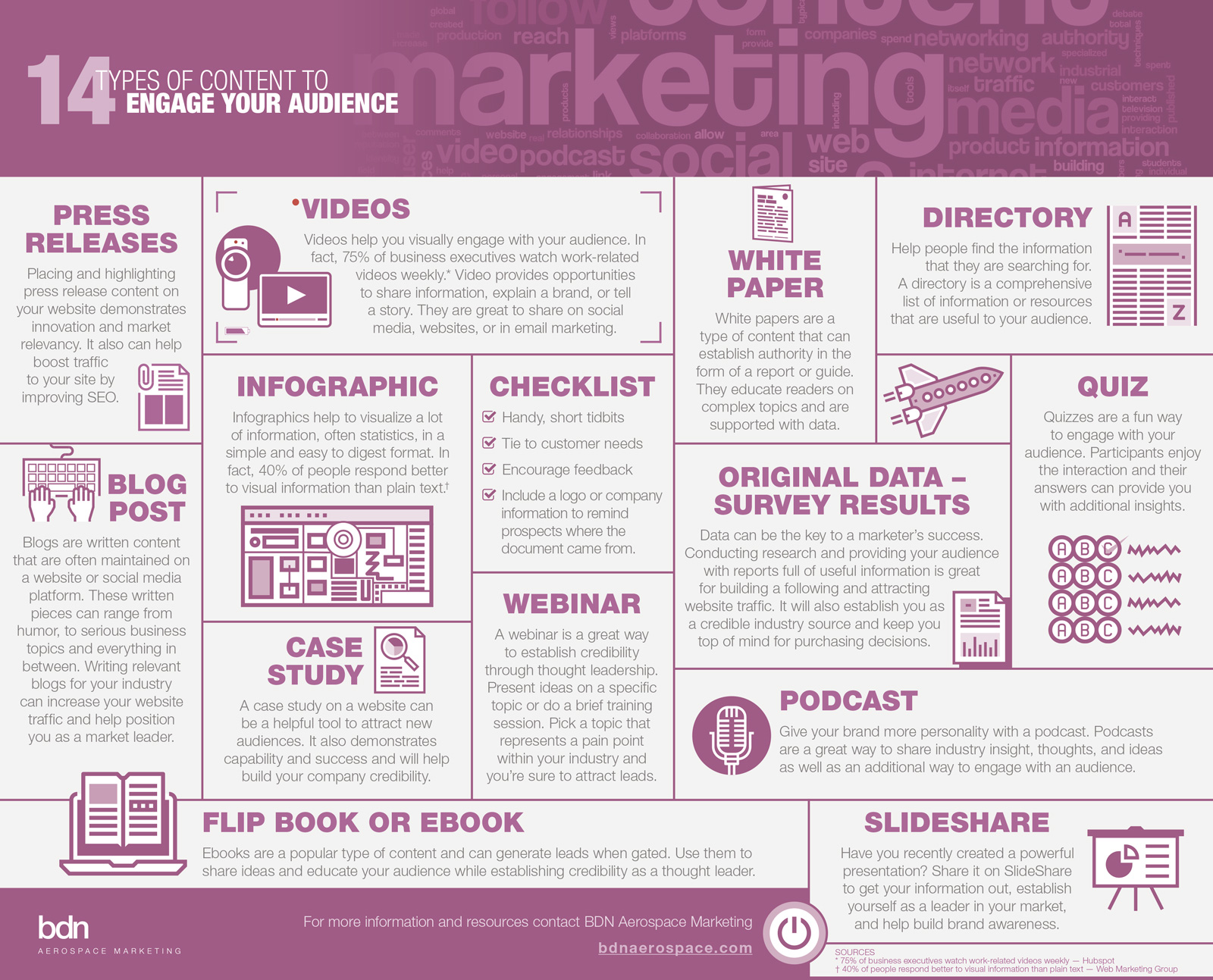Category: BDN
People’s Choice: A&D Marketers ID Preferred Publications
 Because our industry is served by more than 300 aerospace and defense publications, a comprehensive survey determining individual preferences is simply not feasible.
Because our industry is served by more than 300 aerospace and defense publications, a comprehensive survey determining individual preferences is simply not feasible.
Instead, to identify and understand trends, we asked an open-ended question: “If you could only choose to advertise in a few industry publications (print or digital), what would they be?” By not requiring respondents to refer to a list of choices, we hoped to uncover trends in a more organic fashion.
Here’s what we learned, based on the number of write-in “votes” (shown below) for each publication, and congratulations to the top five: Aviation International News, Vertical, AOPA Pilot, Aviation Week & Space Technology, Flying, and Rotor & Wing.

So, what do you think of the list? Is it consistent with your experiences? Whatever your opinion, we’d love to hear from you in the comments section and facilitate a dialogue about the role of advertising in aviation, aerospace and defense marketing.
Next Up:
Our series on the “The Role of Advertising in Aerospace and Defense Marketing,” will continue next week as we share verbatim comments from more than 100 industry marketing professionals who took our survey. Watch for it on April 19.
Don’t Forget:
A more substantial overview of survey findings is available here. Also, if you find our blog and other resources to be useful, please share them with a friend!
SEO Basics for A&D Marketing
 Bad SEO. It happens more than you might think.
Bad SEO. It happens more than you might think.
You just refreshed your aerospace company website, and it looks and sounds great. But no one is seeing it because you forgot about optimizing your website for search engines.
Sure, lots of customers are finding you through referrals and at trade shows, but more and more are looking for you online. In fact, 94 percent of business buyers do at least some type of online research, so search engine optimization (SEO) matters.
No need to feel overwhelmed or intimidated. Search engines, like Google, Yahoo, or Bing, use multiple factors to determine exactly where your website will rank in search results. And don’t worry — SEO isn’t as complicated as you might think. Use this basic primer as a start and you’ll be well on your way to increased organic website traffic from prospective buyers.
What is SEO?
SEO is a combination of efforts to improve organic (unpaid) search rankings.
It includes on-page (factors on your website) and off-page (factors off your website) ranking factors.
Some on-page ranking factors include things like the quality of your content, the inclusion of relevant words and phrases, descriptive meta titles and tags, quick load time, and URLs that include meaningful and relevant keywords.
Off-page ranking factors include the quality of the websites that are linking back to your site, social media links and mentions, and the overall reputation of your website across the Internet.
How do I create good SEO?
There is no shortcut to creating good SEO, but it seems like everyone is looking for a front-of-the-line pass for top-ranking positions. Our best advice? Just produce consistent, relevant and timely content to establish your business as a credible and trustworthy industry expert.
Where should I start?
SEO Must-Haves
- Quick site speed: Make sure that your load time is acceptable. There are plenty of online tools to help you determine your load time, even if you’re not a developer. Check out Moz’s toolbox here.
- Internal linking (linking from pages on your website to other pages on your website)
- Meta data (title tags, descriptions, and image alt tags)
- Mobile friendly
- Social media: Are you making posts on multiple social media platforms that will drive traffic back to your website? Pro tip: Don’t forget about Google owned Google+
- Links on other websites to yours (directories, blogs, etc.): Think about places beyond your website. Are there industry directories or blogs that you can be a part of?
SEO Must-Avoids
- Duplicate content: This might seem like an easy way to have more content or keywords on your website, but Google warns against it. Don’t fall into this trap.
- Hidden text: This is also a “black hat” tactic as Google would call it. It’s a shortcut that could very quickly have you blacklisted by Google
- Keyword stuffing: First and foremost, you need to make sure that your website is readable and user friendly. An overuse of keywords will make your website hard to understand for users
- Link buying: Guest blogging might be a great way to get quality links back to your website, but do not get in the habit of exchanging links and do not ever pay to have a link placed on a website
Want to learn more? Here are three resources for in-depth information:
Sales Enablement: Expert Q&A
 So far this month we’ve talked about inbound marketing, 14 types of content to engage audiences, and lead generation. Each of these activities is part of the lead nurturing process that moves prospects through the funnel toward the ultimate goal of becoming a closed sale.
So far this month we’ve talked about inbound marketing, 14 types of content to engage audiences, and lead generation. Each of these activities is part of the lead nurturing process that moves prospects through the funnel toward the ultimate goal of becoming a closed sale.
Of course, clients don’t always come to us with a request to enable sales — sometimes a discussion begins with ideas for possible solutions to a different perceived problem. But when we confer and dig deeper, the desire to increase sales and revenue is usually what is driving everything, and that makes sense. After all, the purpose of marketing is to enable sales.
In this installment of the Marketing Flight Manual, Lisa Sifuentes, BDN’s Vice President of Client Services and resident sales enablement expert, answers some commonly asked questions.
Why does BDN care about sales enablement? Is it a buzzword or here to stay?
We care about sales enablement because it aligns with our core beliefs that: the purpose of marketing is to enable sales; marketing can and should be accountable for results; and marketing efforts can and should be measured. It is not a buzzword or a flavor of the month — sales enablement is what modern marketers can and should be doing. More importantly, it’s what today’s clients need, want and expect — results, in the form of sales and revenue.
What is sales enablement? Can you give some examples?
Sales enablement is a proven business process that involves activities that sales and marketing teams perform to help sales operate more effectively. Aberdeen Research has shown that leading organizations applying sales enablement techniques are seeing results such as:
- 99% overall team attainment of sales quota
- 9% advantage in year-to-year revenue growth over average companies
- 4% year-over-year growth in average deal size
Just imagine delivering results like these in your organization. It would clearly position you as a business expert, enhancing your credibility and increasing your influence of the marketing function.
What are the challenges associated with sales enablement?
One common challenge is in overcoming the status quo and introducing new ideas and ways or working. Also, effective sales enablement depends on a closely aligned sales and marketing team. These two organizations can no longer act as adversaries but must come together behind a clear and common goal that neither can accomplish alone. Read more about breaking down the wall between sales and marketing at Media Bistro.
Finding the time and resources to measure and track results can also be challenging for aerospace, aviation and defense marketers, but measurement is essential to success. Learn more about measurement in Marketo’s Definitive Guide to Marketing Metrics and Analytics.
What marketing technique(s) might BDN use to help enable sales?
We’ve covered several techniques in this series, but specifically we employ email marketing, content, thought leadership and marketing automation.
Wrapping things up – Can you give our readers three tips to get started?
The most important thing is just getting started, and it’s OK to take baby steps and increase your capabilities for sales enablement over time. With that in mind, here are three things to start with today.
- Make sure your sales team can find and easily deploy content available to them. Simplify the delivery process and communicate.
- A Customer Relationship Management System – get one.
- Content calendar. Have sales and marketing brainstorm types of content that might be useful to your target audiences. You know more than you think and just need to put forward the effort to draft and distribute helpful information and resources.
P.S. Last week we promised more information about how to nurture and guide prospects through the funnel to a closed sale and satisfied customer. Silverpop has a comprehensive white paper, “From Cold to Hot: Lead-Nurturing Programs that Generate Sales” that covers this important topic very well.
Don’t forget: Digital marketing is key to most lead-generation efforts. Download this useful digital marketing guide to learn more.
14 Types of Content To Engage Your Audience
[vc_row][vc_column][vc_column_text]Today’s consumers have learned how to shut out traditional marketing tactics. Television commercials can be fast forwarded and online banner ads no longer grab our immediate attention. Marketers need to adapt their strategies to re-engage and once again capture their customer’s attention.
Content marketing is an effective way to attract and retain customers by consistently creating, curating and providing relevant and valuable information. But what exactly is content?
Check out BDN’s newest infographic below, or download “14 Types of Content To Engage Your Audience” here.
Sources
“75% of business executives watch work-related videos weekly” – Hubspot
“40% of people respond better to visual information than plain text” – Web Marketing Group[/vc_column_text][/vc_column][/vc_row]
How to Make Inbound Marketing Work for Your Aviation Business
 Aerospace and aviation companies looking for every competitive advantage should be taking a closer look at inbound marketing. Inbound delivers a range of important benefits, including:
Aerospace and aviation companies looking for every competitive advantage should be taking a closer look at inbound marketing. Inbound delivers a range of important benefits, including:
- Reaching and engaging closely targeted prospects
- Generating quantifiable leads
- Elevating and building credibility for your brand
- Becoming a thought leader in your market
- Increasing your website traffic and search engine ranking (SEO)
What is Inbound Marketing?
Inbound marketing is a philosophy that challenges traditional, interruptive techniques for an all-new approach based on attraction. It’s designed to complement today’s B2B buying behavior, and it works.
It’s called inbound because it draws potential customers in to you, eliminating the need to reach out with a cold call or email. Just imagine – the customers come to you!
Inbound marketing works when you help your audience find you (via your website) and give them answers to burning questions, hard-to-find information they need or want, help with their most difficult challenges or even authentic inspiration or motivation. In a word, content. We’ll talk more about that in next week’s chapter.
As HubSpot, an inbound marketing authority says, “by publishing the right content in the right place at the right time, your marketing becomes relevant and helpful to your customers, not interruptive.”
The most important thing to remember is this — everyone is looking for help — but no one is looking to be sold.
Why Should You Care?
If you want a more relevant, efficient and effective marketing program, you should care about inbound marketing. Inbound generates more qualified and receptive leads, at less cost with a higher conversion rate, than traditional outbound marketing.
Traditional Marketing Examples
Depending on the plan and frequency, these items can add up fast, potentially totaling hundreds of thousands of dollars.
- Advertising
- Direct Mailers
- Purchasing Lists
Inbound Examples
Depending on your internal resources, many inbound tactics have little or no cost.
- Blogging
- Content
- Subscriber List
If you have something to say, or something to sell, inbound marketing creates an environment by which someone who needs your product can easily find you. And that’s something any marketer can get behind.
What Should I Do to Get Started?
Here are 7 phased steps to jump-start your effort.
Phase 1
- Create and maintain a modern, up-to-date website that is mobile- and search-engine friendly. This is the hub of your inbound program. Be sure to include an area for viewers to subscribe to your content.
- Hold a brainstorm meeting to gather content ideas. Ask yourself “what questions do customers or prospects most frequently ask? What are current hot topics or needs in the market?”
- Create a content and tactical monthly calendar – this should be the foundation for all your marketing-related activities.
- Create and distribute your content through channels like email, social media, website and blogging.
Phase 2
- You should see a spike in website traffic as a result of your content and promotion strategy. Begin converting traffic into leads by using landing pages, savvy calls to action and substantial content and offers.
- Use lead nurturing techniques to convert leads into sales, integrating with your Customer Relationship Management (CRM) software.
- Convert customers into brand ambassadors.
How Can it Work for Aviation, Aerospace and Defense Businesses?
BDN began using inbound techniques for our own business in July 2015, and the results have been more than encouraging. In fact, this blog is one important element of a multi-dimensional strategy that is delivering real results.
A wide variety of B2B businesses in an array of industries are making inbound work for them, and you can, too. Hubspot did a helpful piece about “16 Companies in Boring Industries Creating Remarkable Content,” and if boring industries can do it, imagine the potential for aerospace. Our work and products are exciting, but we default to presenting them in expected, non-interesting ways.
GE — well known within the aviation sector — is breaking away from the norm and is widely recognized for having a best-in-class inbound program that is refreshingly modern and unexpectedly unique and creative. Examples include Pinterest boards entitled “Mind=Blown” and “Badass Machines,” and a humorous take on the Ryan Gosling “Hey Girl” meme featuring Thomas Edison. Other examples include entertaining science-related YouTube videos and Txchnologist, a magazine designed to highlight “the great challenges of our era through industry, technology and ingenuity.”
In addition to BDN’s Inbound Marketing case study and Hubspot, here are some other relevant resources to expand your knowledge and understanding of inbound marketing:
- Learn how to cultivate subscribers and why they are better than leads here.
- Marketo is an alternative to Hubspot.
- Jay Baer is a renowned social media and content marketing consultant and his Convince and Convert blog is a great, worthwhile read.
Don’t forget: Digital marketing is key to most lead-generation efforts. Download this useful digital marketing guide to learn more.
2016 Content Survey
 Does the Marketing Flight Manual meet your needs and address the issues of most concern to you? Please take a moment to complete this survey and help us better understand the types of tools and information that would be most helpful to you as an aerospace/aviation marketer.
Does the Marketing Flight Manual meet your needs and address the issues of most concern to you? Please take a moment to complete this survey and help us better understand the types of tools and information that would be most helpful to you as an aerospace/aviation marketer.
2016 Trade Show Directory
 According to Forrester Research, B2B marketers are spending more on trade shows, conferences and events than on any other marketing tactic, and events are essential to most aerospace marketers.
According to Forrester Research, B2B marketers are spending more on trade shows, conferences and events than on any other marketing tactic, and events are essential to most aerospace marketers.
Year after year, this handy directory of more than 250 aerospace, defense and aviation events is our most popular download. It’s the ultimate industry event reference — get yours today.
15 Cool and Clever Gift Ideas For Aviation Marketers To Give
 It’s December, and for marketers, ‘tis the season to be creative and clever in our professional gift giving.
It’s December, and for marketers, ‘tis the season to be creative and clever in our professional gift giving.
So, just in time for the holidays, the BDN elves are here to help with a list of 15 unexpected and inspired ideas for that hard-to-buy for guy or gal. Everything on the list was hand-picked by our resourceful team members for a range of budgets and personalities — there really is something for everyone.
So what are you waiting for? Let the shopping begin.
Make it personal
1. Marketers spend endless hours fine-tuning projects to make sure every detail is just right. Turning one of those projects in to a piece of art can be a great gift. BDN has had great success with this in the past. One client loved their framed ad enough to order more prints as facility artwork. Another proudly displays it in her office.
2. Why not create a basket of favorites? Have members of your team select items that represent them well. Consider gifts such as books, food, tea or coffee — really anything that can fit in your customized gift basket.
3. An old school journal is a great way to jot down good ideas when you aren’t connected. Make it special with a handwritten note on the first page.
Make it practical
4. Road warriors may enjoy a multi-purpose, travel-friendly TSA-approved tool like this.
5. Create a convenient, hands-free stand anywhere with a gooseneck tablet holder. Clamp it to the edge of a desk, airplane tray or favorite easy chair and adjust. Available for phones, too.
6. Coffee lovers who travel don’t always have the luxury of an in-room coffee maker, and that means waiting in line at the nearest Starbucks. A packable coffee maker (with tote bag) is the ideal alternative.
7. Send your customer a collection of small gift cards that they can share throughout the office. Buy someone a cup of coffee from Starbucks with a gift card, a burrito from Chipotle for a quick lunch, or even a gift card for happy hour to celebrate a hard day’s work. Keep the amounts small to provide a wide variety and a fun little pick-me-up that can be shared around the office.
Make it unique
8. Etsy is an online marketplace where people make, sell and buy unique goods. We did a quick search using the term “jet aircraft” and found everything from beautiful aircraft models to one-of-a-kind photography, unique vintage memorabilia and hand-crafted jewelry.
9. Chances are, your giftee does not already have a bubble wrap calendar. What an unexpected and fun idea. Perfect for the office gift exchange.
10. Find some gifts that are seasonal but relate just to your industry. Your business could send this aviation nutcracker or some themed ornaments.
Make it cool
11. You’d be hard-pressed to find an aviation geek who wouldn’t get excited by a camera drone. There are plenty of products for a range of budgets. Here’s one option.
12. Cordless, 3D printing pen? Yes, please!
13. Selfie sticks are all the rage and make it easy to shoot people and places (with an aircraft in the background, of course) with just your phone.
Pay it forward
14. Support other local (small) businesses and send the client some love from your main location. For BDN, we could send Arizona favorites like from the Queen Creek Olive Mill, sweet treats from FluffIt Marshmallows or other community favorites.
15. In lieu of a traditional gift, make a donation to the recipient’s favorite local charity. Not sure if they have a corporate social responsibility platform? Plant a tree in their honor. Places likes the Arbor Day Foundation are ready to help. Be the first to pay it forward and show good will with the spirit of giving.
Give your Aviation Marketing a Lift!
2016 is just around the corner. Make it a resolution to take your marketing to the next level. The experts at BDN Aerospace Marketing have pulled together this infographic on 12 Secrets to Marketing Success.
Need resources to help you accomplish these tasks? Check out our free Marketing Tool Kit.
You can also download the full graphic here.
Sources
- 85% of aerospace marketers report having a plan (Columbia Business School’s Center on Global Brand Leadership and the New York American Marketing Association)
- 36% of aerospace marketers don’t set goals at all; only 18% measure (Columbia Business School’s Center on Global Brand Leadership and the New York American Marketing Association)
- 80% of B2B decision makers prefer to get information from articles vs. advertising (Roper Public Affairs)
- B2B orgs with aligned sales/marketing orgs have 38% higher sales win rates (CMO Council)
- 67% of online consumers want clear detailed photos more than product information (Wishpond)
- Spending on sales enablement technology has increased 69% in past 2 years (Business 2 Community)
- 61% of global Internet users research products online (Interconnected World: Shopping and Personal Finance)
- 78% of CMOs think custom content is the future of marketing (The Drum)
- 95% of buyers choose provider offering best content help (DemandGen Report)
- 50% of B2B campaigns fail because the message was not matched with the correct audience. (Frantz Group)
Tradeshow Evaluation Checklist
 Trade shows, events and conferences are important opportunities for aerospace industry marketers. Before you commit to a schedule for the year, carefully consider and evaluate what you’ll get for your investment. This checklist will help.
Trade shows, events and conferences are important opportunities for aerospace industry marketers. Before you commit to a schedule for the year, carefully consider and evaluate what you’ll get for your investment. This checklist will help.
And don’t forget to download this comprehensive list of more than 300 A&D industry trade shows. It’s invaluable for planning and is our most popular resource.


